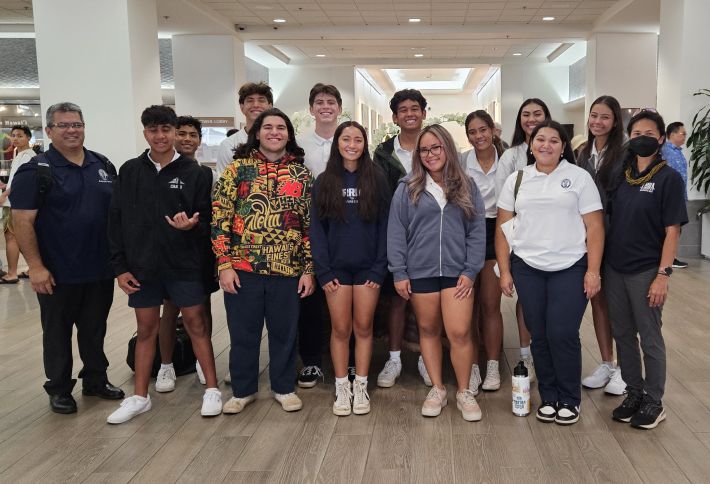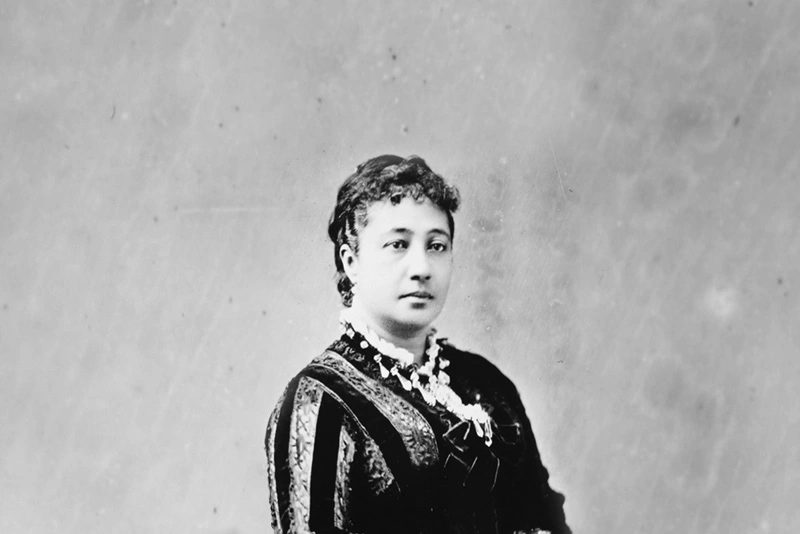KS Maui haumāna Haven De Silva and ʻĪmaikalani Kramer recently returned home after attending the world’s largest celebration of Indigenous Pacific islanders, calling it an “eye-opening” and possibly “once-in-a-lifetime” experience that they hope to share with their classmates next school year.
The two incoming seniors and 10 other high schoolers attended the 13th Festival of Pacific Arts & Culture at the Hawaiʻi Convention Center in Honolulu, earlier this month. The festival was highlighted by a three-day conference series showcasing lifestyles, arts and discourse from Indigenous people across the Pacific islands.
“I initially had no idea what it was,” De Silva said. “I was reading the schedule they sent us and it looked really cool. I was excited to go. I had no idea what I was getting into, but I’m really glad I went.”
The three-day event called, “Moananuiākea: Pacific Conversations and Cultural Exchange,” marked the first time FestPAC featured formalized knowledge-sharing seminars and entrusted school-age youth with integral roles. From offering oli at opening protocols to monitoring breakout sessions, haumāna facilitated the cultural exchange, demonstrated indigenous dance and engaged in profound dialogues, celebrating their heritage and embodying youth-driven activism.
De Silva said she and Kramer volunteered in different session groups and had the opportunity to talk with Indigenous leaders from across the Pacific. The leaders shared with them their challenges and protests against how their nation transports important cultural items, including iwi of native endangered species.
“What I got to listen to was amazing,” she said. “I listened to their struggles and it was interesting to hear how different, but similar their challenges were to ours.”
Kramer said he was grateful to be selected as a delegate to volunteer and participate in the sessions. He was impressed by the number of people who attended the conference and being able to walk through each exhibit while nations demonstrated their own cultural practices.
“I thought it was amazing,” he said. “I thought it was a great way to exchange our culture with our Polynesian cousins.”
 The three-day event, Moananuiākea: Pacific Conversations and Cultural Exchange, tapped youth from nations across the Pacific with offering oli at opening protocols, monitoring breakout sessions and facilitating cultural exchange.
The three-day event, Moananuiākea: Pacific Conversations and Cultural Exchange, tapped youth from nations across the Pacific with offering oli at opening protocols, monitoring breakout sessions and facilitating cultural exchange.
Kramer said he learned dances from Tahitian, Fijian and Taiwanese students, a creation story from Samoa and a hukihuki-type game from Aotearoa. He said he was eager to learn and engage with the activities.
“I’m pretty outgoing, so I try to get involved,” he said. “It was definitely different though. I’ve done things I’ve never seen or thought of. Taiwan was showing us how to dance and everyone was dancing in their groups, but then everyone started going into a circle. I gradually joined in and it was almost like a mosh pit. It was actually super fun.”
Hope Po‘o Māhele Luna Kaleo Pahukula and Māhele Luna Dean of Learning Brooke Holderbaum also attended the festival and conference to serve as chaperones for the KS Maui haumāna. Pahukula said he was proud of how the haumāna engaged with others, participated in activities, led protocol, and learned about the cultures from across Moananuiākea.
“It was an honor to attend myself but I am especially happy for our haumāna who had this experience of a lifetime,” he said. “Mahalo to everyone who organized this amazing event.”
Holderbaum came away from the experience feeling that all ʻōiwi leaders should be required to learn from FestPAC. She said the festival is a place to make human connections and connections to treasured elements of our culture.
“It is a place to reaffirm that Moananuiākea is the largest ʻnation’ in the world,” she said. “It is the home of those who have cared for oceans and lived sustainably for generations before Western land grabs and colonization. Whether one is just beginning to explore their cultural identity or loea in a particular practice, FestPAC 2024 was a warm, welcoming space to learn, grow, and share generously with one another. Our haumāna surely felt it and embraced their kuleana with a sense of aloha that would make Pauahi smile.”
De Silva said she had so much fun at the three-day conference that she immediately flew back to attend the remaining days of the festival. She begged her aunt, Shantell (Ching) De Silva, to let her stay at her home.
“I told her, ʻPlease take me’, and she took me everywhere,” Haven De Silva said of her aunt, who is a navigator and sailed on Hōkūleʻa. “She introduced me to so many people.”
Among the people she got to meet were master navigator Papa Mau Piailug’s son, Henry Yarofalpiy. She also had the opportunity to observe the Marumaru Atua depart for the Cook Islands. The vessel is the only Cook Islands traditional canoe that is operated today.
 Youth delegates from Rapanui help KS Maui haumāna learn to tell moʻolelo with hei (string). Polyneisan cultures use string to tell, remember, and illustrate moʻolelo through mele and sequences requiring increasing manual dexterity. The images created by the string represent characters or scenes in the moʻolelo. In the activity, Rapanui performed several kiʻi hei and taught participants as well.
Youth delegates from Rapanui help KS Maui haumāna learn to tell moʻolelo with hei (string). Polyneisan cultures use string to tell, remember, and illustrate moʻolelo through mele and sequences requiring increasing manual dexterity. The images created by the string represent characters or scenes in the moʻolelo. In the activity, Rapanui performed several kiʻi hei and taught participants as well.
De Silva said she was grateful for the opportunity to attend the festival and that it reignited her passion for navigation and the ocean.
“When I was younger, I loved learning about navigation and everything about the waʻa,” she said. “As I got older, I got more involved with sports and school and it kind of left my brain.
“But just watching them leave (Marumaru Atua), I was like, ʻOh, take me with you’.”
Attending the conference also “lit a fire” beneath Kramer, who is looking to pursue ʻōlelo Hawaiʻi in college. He said he was inspired by the pride and care other nations had for their culture and background, but also eager to learn about others.
“What I learned from this event is that our kūpuna know the most about our culture,” he said. “As students and keiki, we have to not be afraid to ask questions, so we can hold that ʻike when our kūpuna pass.”
Looking at next school year, De Silva hopes to facilitate or host something to share the experiences she and her small group of classmates participated in at the festival. De Silva will be entering as the new president of the Associated Students of the Kamehameha Schools Maui Campus, while Kramer will serve as the spirit chair.
“I had no idea what FestPAC was and when I got there, I was like, ʻHow does everyone not know about this,’” De Silva said.

The 12 KS Maui haumāna were supported by Hope Po‘o Māhele Luna Kaleo Pahukula (far left) and Māhele Luna Dean of Learning Brooke Holderbaum (far right).
TAGS
maui campus,ks maui,kanaeokana,kaiāulu,kaiwakiloumoku,community events,native hawaiian identity
CATEGORIES
Kaipuolono Article, Regions, Maui, Moloka’i and Lana’i, Themes, Culture, Community, KS Announcements, Maui Newsroom, KS Maui Home, Newsroom, Maui, Community Events, KS Kaiāulu, Oiwi Leaders
Print with photos
Print text only










